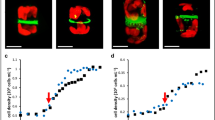Abstract.
Mineral cell coverings are found in various protists. Some macroalgae accumulate calcium carbonate in the intercellular space, and some unicellular organisms use calcium carbonate or silica for the construction of loricas, scales, and frustules. Diatoms are representatives of those utilizing silica for the material of the cell covering called a frustule. The development of the frustule is initiated in a silica-deposition vesicle (SDV), which occurs just beneath the plasma membrane and, subsequently, the silicified cell covering expands its area, following the expansion of the SDV from valve face to valve mantle. Sequential valve development with whole valves is reviewed in several diatoms placed in different phylogenetic positions. Every diatom commences its valve formation from its pattern center and then develops by means of individual procedures. The results indicate that the valve development reflects the phylogeny of diatoms. In addition, recent progress in silica biomineralization is briefly reviewed, and the phylogeny of ability concerning siliceous cell covering formation is inferred.
Similar content being viewed by others
Author information
Authors and Affiliations
Additional information
Electronic Publication
Rights and permissions
About this article
Cite this article
Mayama, S., Kuriyama, A. Diversity of mineral cell coverings and their formation processes: a review focused on the siliceous cell coverings. J Plant Res 115, 289–295 (2002). https://doi.org/10.1007/s10265-002-0039-5
Received:
Accepted:
Issue Date:
DOI: https://doi.org/10.1007/s10265-002-0039-5




